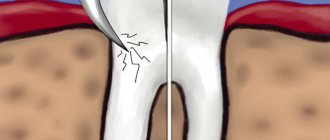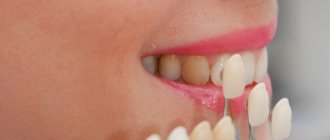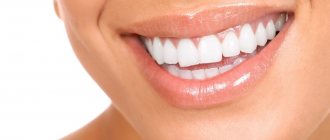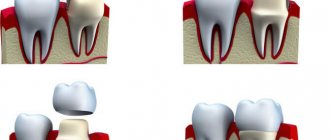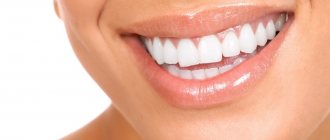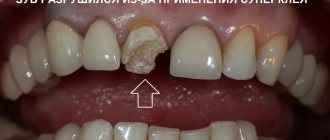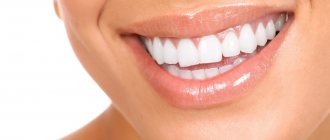Darkening of the tooth near the gum can be caused by various reasons. Not all of them are associated with dental diseases and pathological processes in the oral cavity. For example, sometimes a tooth darkens due to taking medications containing iron gluconate, or excessive consumption of grape or tomato juice.
However, in most cases, the causes of darkening of the tooth near the root and gums are pathological processes. This is a reason to immediately contact a dentist. The following diseases lead to this symptom:
- Cervical caries;
- Tartar;
- Fluorosis.
Let's talk about these diseases and methods of treating them in more detail.
Cervical caries
Cervical caries is localized on the neck of the tooth - the place where the enamel comes into contact with the gum. This pathological process occurs very quickly, which makes it one of the most dangerous types of this disease. Cervical caries can develop into pulpitis, periodontitis or a root pathological process within just a few months. It is much faster than localized, for example, on the vestibular or occulus surface.
Cervical caries requires immediate treatment. If the disease is started, the pathological process will quickly “spread” to the roots of the tooth. In this case, the patient will begin to experience acute pain. When the roots are destroyed, it becomes impossible to save the tooth, and the only way to “treat” is removal.
But there are also advantages. If cervical caries is detected at an early stage, when the pathological process has not yet affected the dentin and roots of the tooth, this disease can be cured using a conservative method. The dentist will perform fluoridation and remineralization of the enamel, restoring its strength. In this case, preparation is not required or minimal.
If the pathological process has reached the dentin - the patient is concerned not only about the darkening of the tooth, and increased sensitivity, as well as pain - then treatment is carried out by filling. The dentist removes the destroyed tissue, then cleans the tooth from the remains of harmful microorganisms and closes it with a filling.
The most common cause of cervical caries is insufficient dental hygiene. To prevent this disease, it is necessary to brush your teeth regularly, at least 2 times a day, use floss (dental floss), and, if you are predisposed, use an irrigator.
When is it time to sound the alarm? Symptoms and stages of tooth decay
There are a number of signs that should alert you. Having noticed one or two of them, a person should become concerned and see a specialist. This:
- 1. Accumulation of plaque on tooth enamel. Barely noticeable yellowish spots.
- 2. Bad breath, even the smell of rotten breath. With severe caries, the smell will be very noticeable.
- 3. Dark spots on the enamel. Painful sensations when eating hot or cold, sweet foods.
- 4. If you ignore the above-mentioned manifestations of ill health, the situation gets worse. Next, black areas appear in the area of the neck of the tooth or on the root itself, but the latter can only be detected during an X-ray examination.
- 5. Frequent aching painful sensations appear, and even if you regularly rinse your mouth with herbal infusions and take painkillers, the destructive processes are in full swing.
- 6. The pain intensifies (especially when a stream of cold air hits the tooth), and the pulp begins to die.
- 7. The nerve bundle is affected, the pain becomes especially severe.
- 8. Then, if the person never went to the hospital, he notices with surprise and relief that the pain goes away. However, in reality, the inflammatory process does not stop - the disease spreads to the root area.
Tartar
Tartar is a bacterial-mineral plaque that forms on the cervical surface of the enamel due to insufficient oral hygiene, as well as due to smoking and an incorrect diet.
First, a soft coating forms on the surface. It consists of bacteria and food debris. Soft plaque is easy to clean - it is removed even when chewing carrots, apples and other hard foods, as well as during oral hygiene using a toothbrush, floss or irrigator.
However, if a person does not remove the soft plaque, it can begin to petrify - change its structure, become hard and mineral. Turn into tartar. Hard plaque is much more difficult to remove - it often even resists cleaning with a classic brush.
Tartar is not only unsightly, it is also the cause of many diseases. For example, it can cause gingivitis and other gum inflammations. This occurs due to contact between bacteria and soft tissues of the oral cavity. But the most dangerous consequence of tartar is periodontitis, the inflammatory process of the periodontium, the tissues surrounding the roots and base of the tooth. It can lead to tooth mobility and loss.
Tartar treatment is quick and comfortable. Ultrasound, laser, or Air Flow technology can be used to break down mineral deposits. The dentist chooses a specific technique depending on the characteristics of the disease. Thus, thin dental plaque is cleaned using the Air Flow method - mineral deposits are removed by a water-air flow with the addition of active substances.
Causes of darkening of tooth enamel
The cause of tooth discoloration can be not only staining of the enamel, but also darkening of the hard tissue underneath. While the first may simply be the result of eating habits, the second indicates the presence of an internal problem.
Dark enamel in all or most of the teeth may appear due to the following reasons:
- Excessive consumption of coffee and strong tea,
- Smoking
- Metabolic disease
- Long-term use of certain medications, such as tetracycline-based antibiotics
- Reaction to filling material
- thinning of the enamel after nerve removal.
From smoking, tobacco tars accumulate on the teeth, which are not completely removed during normal hygiene procedures. Food dyes from some foods, as well as tea, coffee and other drinks, also tend to “eat” into the enamel over time.
Improper metabolism leads to an imbalance in the acid-base balance in the mouth, which causes bacteria to multiply more actively and plaque to form more actively. That is, a patient whose enamel of all teeth has darkened should pay attention to the condition of the gastrointestinal tract.
Some medications have the ability to change the pigmentation of enamel, for example, antibiotics from the tetracycline group or iron-containing drugs taken in liquid form.
Darkening can also occur when using outdated filling materials containing metals (silver or even tin). But even modern materials, under incorrect storage conditions, change their properties and adversely affect the color of the enamel.
The “wear and tear” factor cannot be ignored. If the tooth has been depulped for a long time, then it is not supplied with useful substances. This means that all mechanical actions lead to abrasion of the enamel and gradual destruction. Careful care slows down this process, but does not completely eliminate it.
Often the patient cannot understand why dark teeth appeared in a row against the background of others that were still light. This may mean that a pathological process has occurred under the still intact tooth crown, which has changed the color of the hard tissue - dentin.
Darkening of dentin can be due to the following reasons:
- untreated caries or its relapse
- advanced stage of pulpitis
- poor quality pulp removal
- injury from a strong blow
Caries destroys part of the protective layer of tooth enamel and gets underneath it. As the infection continues to develop, it affects the internal tissues, causing them to turn black. The affected dentin shows through the enamel, so the tooth can stand out noticeably among its white “neighbors.”
Pulpitis is often accompanied by pain, which brings the patient to the dentist even before the pulp dies. But if treatment was not carried out at the acute stage, then the chronic stage begins. At this stage, the pulp (nerve) begins to die, which changes the color of the tooth.
After removal of the nerve, if the operation was performed poorly, the color may also change. Insufficiently thorough cleaning of the canals will cause further decomposition of the remaining pulp. If not all cavities are filled with filling material, then microbes will again penetrate into the remaining voids. All this will again cause darkening of the dentin. Less commonly, the cause of darkening may be the paste used to seal the root after cleaning the canals. Sometimes its composition changes the shade of hard tissues.
Trauma to a tooth causes it to darken due to blood entering the bone tissue.
Sometimes, if a tooth has been restored, the pins may be visible through the filling compound. In this case, repeated restoration may be required.
Fluorosis
Fluorosis is a dangerous dental disease that is caused by consuming extremely large doses of fluoride. Usually this substance enters the human body along with tap water. In addition, the source of fluoride can be the work environment or even the wrong toothpaste.
Fluorosis begins with the appearance of white, dull spots on the surface of the teeth. They are not always visible to the naked eye. Over time, the spots change color - they first turn yellow, then turn brown. If you don’t consult a dentist at this point, fluorosis can turn into erosive or destructive forms - when the disease begins to destroy the enamel.
Treatment of fluorosis is almost always conservative. The dentist remineralizes the enamel, restoring the balance of calcium, phosphorus and fluoride. Darkened areas are bleached. In addition, the patient is recommended to change his lifestyle to reduce the amount of fluoride consumed - for example, install a special water filter at home or change his place of work.
Fluorosis is often “epidemic” in nature. If it is caused by an increased content of fluoride in tap water, it develops in the whole family. If the reason was a violation of industrial safety - for the entire team. In the Ryazan region, fluorosis is often detected in residents of the Rybnovsky, Chuchkovsky and Shatsky districts, where the water contains an increased amount of fluoride.
Why can baby teeth turn black?
Baby teeth are much more susceptible to caries than molars, since they do not have such a dense structure. Enamel can change color due to the development of various pathological processes that can be provoked in a child:
- fragility of tooth enamel;
- calcium deficiency;
- improper oral care;
- chips and cracks in the enamel;
- vitamin deficiency;
- endemic fluorosis;
- chronic gastrointestinal diseases;
- genetics.
Sometimes the cause of darkening of the teeth of very young patients is artificial feeding of the baby at night. Consuming formula or milk at night reduces saliva production. The acid that accumulates on the teeth during feeding is not washed away by saliva and the process of destruction of tooth enamel begins.
Treatment of a darkened tooth
Darkening of the tooth near the gum requires immediate consultation with a doctor, regardless of the cause. If you leave the disease to its own devices, you can face more dangerous and serious consequences.
The doctors at our regional dental clinic are ready to help. We use modern equipment, progressive therapeutic practices and always put the patient's comfort as a priority. Therefore, treatment of a darkened tooth will be quick and effective. Don’t let the disease lead to dangerous consequences - make an appointment with the dentist!
Signs of violations
Blackening of a tooth can be discovered by chance - for example, when replacing a bridge, one of the supporting teeth turned out to be dark. Or, the fact that there is a rotten or decaying tooth under the crown is indicated by indirect signs:
- An unpleasant odor that is noticed by the patient himself and those around him.
- The tooth reacts to temperature and strong tastes. If you run your tongue over the crown, you will notice a gap between it and the gum.
- Pain. Periodic or constant. Or itching or other strange sensations.
If one of the symptoms appears, you should immediately consult a doctor. Even when there is no sharp pain and unpleasant sensations appear and go away on their own. The tooth under the crown has already begun to deteriorate and the sooner treatment is started, the more effective it will be.
How to remove black plaque from teeth?
Since it is impossible to remove black plaque from teeth at home, you must definitely contact a dental clinic. The first thing the doctor should do is interview the patient and find out the supposed cause of dark plaque on the teeth. Well, if it’s just a matter of love for coffee and cigarettes, then you can be sure that regular teeth cleaning using professional equipment will eliminate the problem. But what to do if your teeth turn black due to other reasons?
The doctor may recommend undergoing certain tests - and perhaps, in parallel with eliminating plaque, treat the cause that caused it. Or eliminate factors that could cause plaque formation. In any case, the cause of plaque must be determined as quickly as possible.
Cleaning teeth from mineralized plaque is usually done using ultrasound. This is the least traumatic method, which has already proven its effectiveness. That is why it is used in large dental clinics. If the reasons why teeth turn black are related to external factors, the doctor may advise further use of a special toothbrush and special pastes designed to combat this problem. Perhaps this will be enough to prevent the reappearance of black plaque on the teeth.


